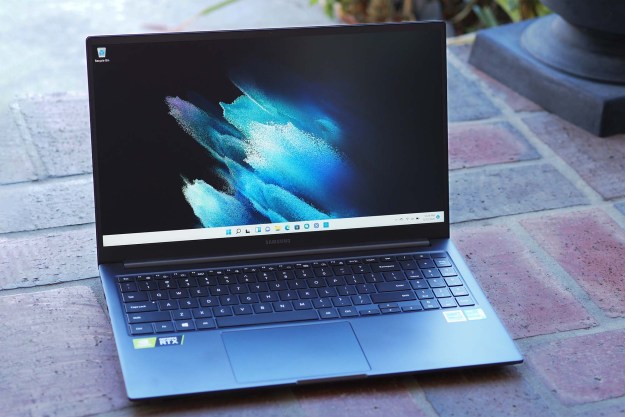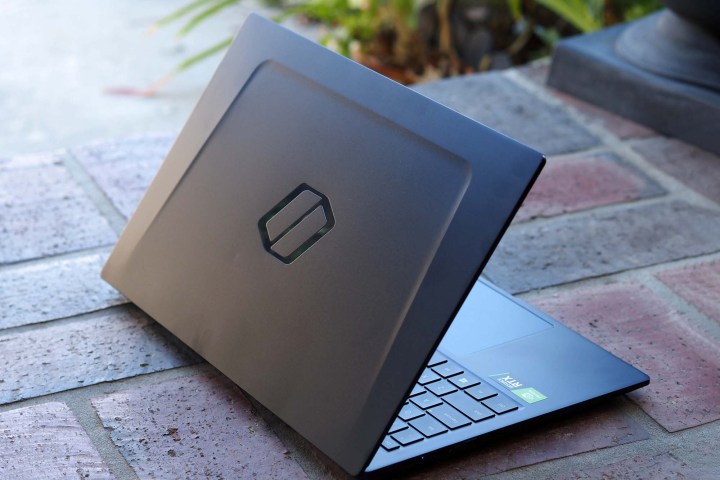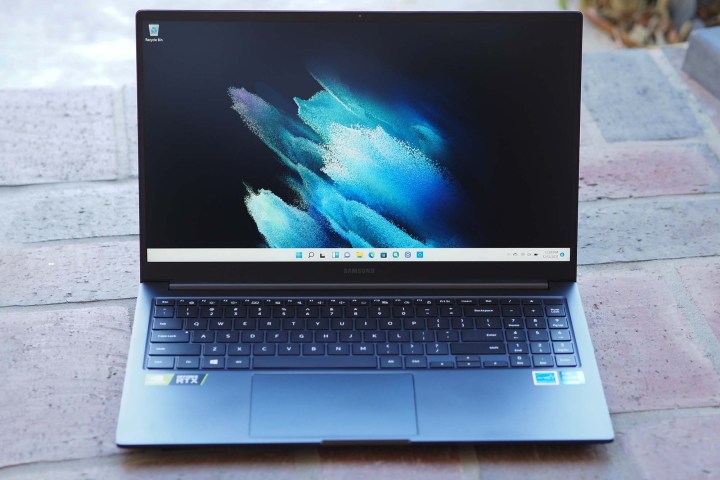
“The Samsung Galaxy Book Odyssey is fast for productivity users and can meet some entry-level gaming needs, but its poor display is a real bummer.”
- Solid productivity performance
- Good keyboard and touchpad
- Attractive design
- Great battery life
- Build quality is slightly subpar
- Display is a real disappointment
- Gaming performance is a little underwhelming
Samsung has been expanding its laptop line, pumping out a new entry-level Galaxy Book and an updated version of the Galaxy Book Pro 360. One of the more interesting introductions is the Galaxy Book Odyssey, which Samsung positions as both a productivity and a gaming machine with a nod to creators. That’s a fine line to walk both aesthetically, where the laptop has some flourishes, and in its performance.
Our review unit retails for $1,400 but is currently on sale for $1,210, a more attractive price for the 11th-gen Intel Core i7-11600H and 15.6-inch 16:9 Full HD (1,920 x 1,080) IPS display. You can spend another $100 and upgrade from 8GB to 16GB of
Design

The Galaxy Book Odyssey is all-aluminum, which usually results in a rigid laptop. In this case, the lid was a bit bendable and there was some flexing in the keyboard deck and chassis bottom. I’ve noticed this tendency in some other Samsung
Aesthetically, the Galaxy Book Odyssey is mostly a minimalist design, particularly along the edges where its angles are simple and streamlined. Its “Mystic Black” is an attractive color that deviates from the more common silver, and there’s some molding on the lid with a bold chrome logo that adds some flair. It’s not as cohesively designed as the XPS 15 nor as colorful as some midrange options from Asus and Lenovo, but it’s a laptop you won’t be embarrassed to carry around. As a gaming laptop, it’s subdued.
Speaking of carrying it around, the Galaxy Book Odyssey is pretty average in size for a laptop with a 16:9 15.6-inch display. The bezels are on the smaller size, not as trim as the XPS 15’s, with only the bottom chin being larger than it could be. Even so, there’s not a lot of fat, and it’s around the same width and depth as the Galaxy Book. It’s 0.70 inches thick and weighs 4.08 pounds, making it just as thick but considerably heavier than the Acer Aspire 5, which comes in at 3.64 pounds. The Galaxy Book Odyssey is pretty much in the Goldilocks zone, neither too small nor too large.
Connectivity is generous with just one disappointment. There’s a full-size HDMI connection, a USB-A 3.2 port, and two USB-C 3.2 ports on the left-hand side with two USB-A 3.2 ports, an Ethernet jack, a 3.5mm audio jack, and a microSD card reader on the right-hand side. The disappointment is no
Power is provided via USB-C through a large 135-watt power adapter that exceeds the usual 100-watt USB-C limit.
Performance

The Galaxy Book Odyssey is built around an 11th-gen Intel Core i7-11600H, a 45-watt CPU with six cores and 12 threads. That sits in between Intel’s 4-core/8-thread 28-watt U-series CPUs and the 8-core/16-thread 45-watt H-series processors. As such, I expected to see solid productivity performance and, with the Nvidia GeForce RTX 3050 Ti, perhaps even some creativity performance to go with it.
As it turned out, the Galaxy Book Odyssey performed as I expected in our non-gaming benchmarks. It didn’t impress in Geekbench 5, falling behind the Lenovo IdeaPad Slim 71 Pro with a 35-watt 4-core/8-thread Core i7-11370H but ahead of the Microsoft Surface Laptop Studio with the same CPU. It couldn’t keep up with either the AMD Ryzen 7 5700U or the Core i7-11800H, also as expected. In our Handbrake test that encodes a 420MB video as H.265, the Galaxy Book Odyssey did well, beating out all but the Ryzen 7 and the Core i7-11800H. In Cinebench R23, the Samsung took second place, surprisingly beating the Ryzen 7 that typically performs well in this benchmark. Finally, in the PCMark 10 Complete benchmark that’s the best indication of productivity performance, the Galaxy Book Odyssey again came in second place with a strong showing across the Essentials, Productivity, and Content Creation portions of the test.
I also ran the laptop through the Pugetbench benchmark that runs in Adobe Premiere Pro, where it scored 318. That’s lower than the Microsoft Surface Laptop Studio that also equips the RTX 3050 Ti, and the Lenovo ThinkPad X1 Extreme Gen 4 with its Core i7-11800H and RTX 3060. It’s faster than a laptop like the Samsung Galaxy Book Pro 360 with a U-series Core i7-1165G7 that scored 241 but not as high as I was hoping. Creators can use the Galaxy Book Pro Odyssey for their work, but it’s going to lag.
Overall, the Galaxy Book Odyssey is a strong productivity performer and good enough for lower-end creativity tasks. You’ll find some other 15-inch
| Geekbench (single/multi) | Handbrake (seconds) |
Cinebench R23 (single/multi) | PCMark 10 | Pugetbench | |
| Samsung Galaxy Book Odyssey (Core i7-11600H) | 1478 / 5366 | 151 | 1601 / 8571 | 5989 | 318 |
| Lenovo IdeaPad Slim 7i Pro (Core i7-11370H) | 1578 / 5957 | 202 | 1514 / 5544 | 5149 | N/A |
| Dell Inspiron 14 2-in-1 (Ryzen 7 5700U) | 1184 / 6281 | 120 | 1287 / 8013 | 5411 | N/A |
| Lenovo ThinkPad X1 Carbon Gen 9 (Core i7-1165G7) | 1327 / 5201 | N/A | 1469 / 4945 | 5147 | N/A |
| Microsoft Surface Laptop Studio (Core i7-11370H) | 1321 / 5131 | 179 | 1304 / 5450 | 5091 | 417 |
| Lenovo ThinkPad X1 Extreme Gen 4 (Core i7-11800H) | 1520 / 7353 | 106 | 1519 / 10497 | 6251 | 432 |
| MSI Sumit E13 Flip Evo (Core i7-1185G7) | 1352 / 4891 | 207 | 1360 / 4392 | 4872 | N/A |
Gaming performance
Because Samsung has positioned the Galaxy Book Odyssey as a part-time gaming machine, it’s fair to compare it to its competition. With an RTX 3050 Ti installed, that means low-end
I usually start discussing benchmarks with 3DMark Time Spy, but for some reason, the Galaxy Book Odyssey wouldn’t install 3DMark. It went 60% of the way through the installation routine and then just hung out there until I rebooted. So, strike that test.
Running actual games, the Galaxy Book Odyssey wasn’t our comparison group’s fastest
That’s a decent result given that Samsung wanted this laptop to be both a productivity workhorse — where it performed well — and a part-time gaming machine. I’d say Samsung mostly succeeded.
| Laptop | Assassin’s Creed Valhalla (1080p Ultra High) |
Battlefield V (1080p Ultra) |
Fortnite (1080p Epic) |
Civilization VI (1080p Ultra) |
| Samsung Galaxy Book Odyssey (RTX 3050 Ti) |
15 fps | 40 fps | 54 fps | 61 fps |
| Microsoft Surface Laptop Studio (RTX 3050 TI) | 47 fps (1200p) | 51 fps | 47 fps | 75 fps |
| Asus ROG Flow X13 (RTX 3050 Ti) | 7 fps (1200p | 52 fps | 57 fps | 65 fps |
| Acer Swift X (RTX 3050 Ti) | N/A | N/A | 43 fps | 66 fps |
| HP Victus 16 (RTX 3060) |
59 fps | 72 fps | 99 fps | 118 fps |
| Razer Blade 14 (RTX 3070) |
60 fps | 96 fps | 96 fps | 111 fps |
Display

Whoops, they did it again. For a company that sources excellent displays for so many other manufacturers, Samsung can choose some inferior panels for its own
Subjectively, the display doesn’t look terrible. For my productivity workflow, such as writing this review, it sufficed. The colors were okay, and the contrast wasn’t so bad that black text was a light grey. But the screen didn’t jump out at me. It’s just Full HD, meaning that it’s not sharp at the 15.6-inch size, and it’s in the old-school 16:9 aspect ratio.
Perhaps most importantly, Samsung is aiming this laptop at least in part at creators, and they would hate this display.
My colorimeter agreed with me. While the display was bright enough at 350 nits (300 is our threshold for a display that can overcome most bright lighting conditions), its colors were incredibly narrow for a premium laptop at just 48% of AdobeRGB and 65% of sRGB — we expect to see at least 70% of AdobeRGB and 95% of sRGB from similarly price machines. Those colors also weren’t terribly accurate at a DeltaE of 2.37 (1.0 or less is considered excellent), where premium

It’s not that this is a terrible display for simple productivity work, but if you want to use it for viewing photos and video, then you’ll be disappointed with the colors. And text didn’t pop on white backgrounds, making the display less than ideal for writers and anyone who works with a lot of numbers. Perhaps most important, Samsung is aiming this laptop at least in part at creators, and they would hate this display. Overall, this was my biggest disappointment in the laptop, and quite frankly, I don’t understand why Samsung would choose an inferior panel for its own laptop.
The audio is provided by two downward-firing speakers toward the front of the laptop, and they provided clean sound with pleasant highs and mids and just the slightest touch of bass. The only problem: The volume was incredibly low. I turned the speakers all the way up and thought I still had 50% to go. If you’re in a quiet room watching Netflix, you’ll be fine. But keep a pair of
Keyboard and touchpad

The keyboard has plenty of spacing and even manages to squeeze in a usable numeric keypad. The keycaps are large enough and very slightly sculpted to make them a touch more comfortable. The switch mechanisms are also good, being a bit shallow but redeeming themselves with a comfortable bottoming action with a bit of snap. It’s a precise enough keyboard that’s a step behind the best, such as on the HP Spectre line and Apple’s excellent MacBook keyboards, but it will keep fast touch typists working productively.
The touchpad is large and takes up most of the space on the palm rest. It has some tactile feedback that helps with swiping, and as a Microsoft Precision touchpad (pretty much the norm today), it supports all the
Windows 10 Hello password-less login support is provided by a fingerprint reader embedded in the power button. It was fast and accurate.
Battery life
The Galaxy Book Odyssey enjoys 83 watt-hours of battery capacity, a nice number for a machine with a Full HD 15.6-inch display. I was hopeful that the laptop would live up to its productivity performance with all-day battery life.
I wasn’t disappointed. The laptop hit 10.5 hours on our web browsing test that cycles through a series of popular and complex websites, a solid score that’s much better than the Galaxy Book’s 8.3 hours and the Dell XPS 15 OLED’s nine hours. The Galaxy Book Odyssey went for 14.25 hours in our video test that loops a local Full HD Avengers trailer, another solid score that again beat out the Galaxy Book and XPS 15 OLED at just over 11 hours. I also tested using the PCMark 10 Applications battery test, the best indication of productivity battery life, where the Galaxy Book Odyssey again did well at 11.75 hours compared to the Galaxy Book at just under 11 hours and the XPS 15 OLED at eight hours. And finally, in the PCMark 10 Gaming battery test that shows how hard a laptop works while unplugged, the Galaxy Book Odyssey hit 93 minutes, which is close to average and indicates you’re not giving up much performance when running on battery power.
Overall, these are strong results that indicate the Galaxy Book Odyssey will get you through a full day’s work with some time left over for some evening productivity or media binging. Samsung did a respectable job of creating a laptop that fits the needs of productivity workers.
Our take
I wanted to give the Samsung Galaxy Book Odyssey a higher score. It provides solid productivity performance with the ability to handle some creative duties as well, and while its gaming performance was a little underwhelming, it can still handle 1080p games with decent graphical detail. It has great battery life, sports a good keyboard, and has an excellent touchpad, and its build quality is just a little subpar.
Unfortunately, the display is a huge disappointment. You just can’t provide such narrow colors and low contrast on a laptop in this price range, especially one that’s at least in part aimed at creators. With a better display, I could have easily recommended this laptop, but as it is, I have to give it a pass.
Are there any alternatives?
You can get a Dell XPS 15 for around the same retail price if you drop down in the specs a bit, and it’s probably worth considering for the XPS 15’s excellent build quality and cohesive design. Or, spend a little more and get equivalent performance with a much better display.
The HP Envy 15 is a solid competitor to the Galaxy Book Odyssey. It costs less and offers better performance with a much better display.
How long will it last?
The Samsung Galaxy Book Odyssey has some bending and flexing in the lid and chassis, but it’s not egregious. It should last for several years of typical use, and its components are up-to-date and should handle
Should you buy it?
No. The Galaxy Book Odyssey is competitive in several important ways, but you can get much better displays for the same money — and that matters a lot.
Editors' Recommendations
- The 4 best Samsung laptops for work and play in 2024
- Samsung Galaxy Book 3 Ultra vs. MacBook Pro 16-inch
- Samsung Galaxy Book 2 Pro 360 hands-on review: A sturdy sequel
- Samsung Galaxy Book leak reveals a wild 14-core Intel Alder Lake processor
- Samsung Galaxy Book Pro 360 vs. HP Spectre x360




